Principles of Professional Working: Relationships, Patient Rights
VerifiedAdded on 2021/05/31
|19
|1422
|57
Report
AI Summary
This report delves into the principles of professional working, examining the dynamics of relationships within a professional context, including interactions with colleagues and clients. It explores the significance of fostering positive relationships to enhance team productivity and achieve organizational goals. The report highlights the importance of patient rights, responsibilities, and empowerment in healthcare settings, along with different doctor-patient relationship models. It also addresses the awareness and potential violations of patient rights, and provides strategies for effective conflict resolution, emphasizing communication, mediation, and compromise. The conclusion underscores the vital role of maintaining positive professional relationships and open communication for organizational success and patient care.

PRINCIPLES OF
PROFESSIONAL WORKING
Name of the Student
Name of the University
PROFESSIONAL WORKING
Name of the Student
Name of the University
Paraphrase This Document
Need a fresh take? Get an instant paraphrase of this document with our AI Paraphraser

INTRODUCTION
• Professional relationships encompass the
relation that occur between two people
who respond to and receive the demands
or requests that are placed forth.
• Professional dilemmas and tensions in
workforce generally arise from extrinsic
and intrinsic sources.
• Relationship between coworkers are often
circumstantial, in addition to being
professional
• Professional relationships encompass the
relation that occur between two people
who respond to and receive the demands
or requests that are placed forth.
• Professional dilemmas and tensions in
workforce generally arise from extrinsic
and intrinsic sources.
• Relationship between coworkers are often
circumstantial, in addition to being
professional
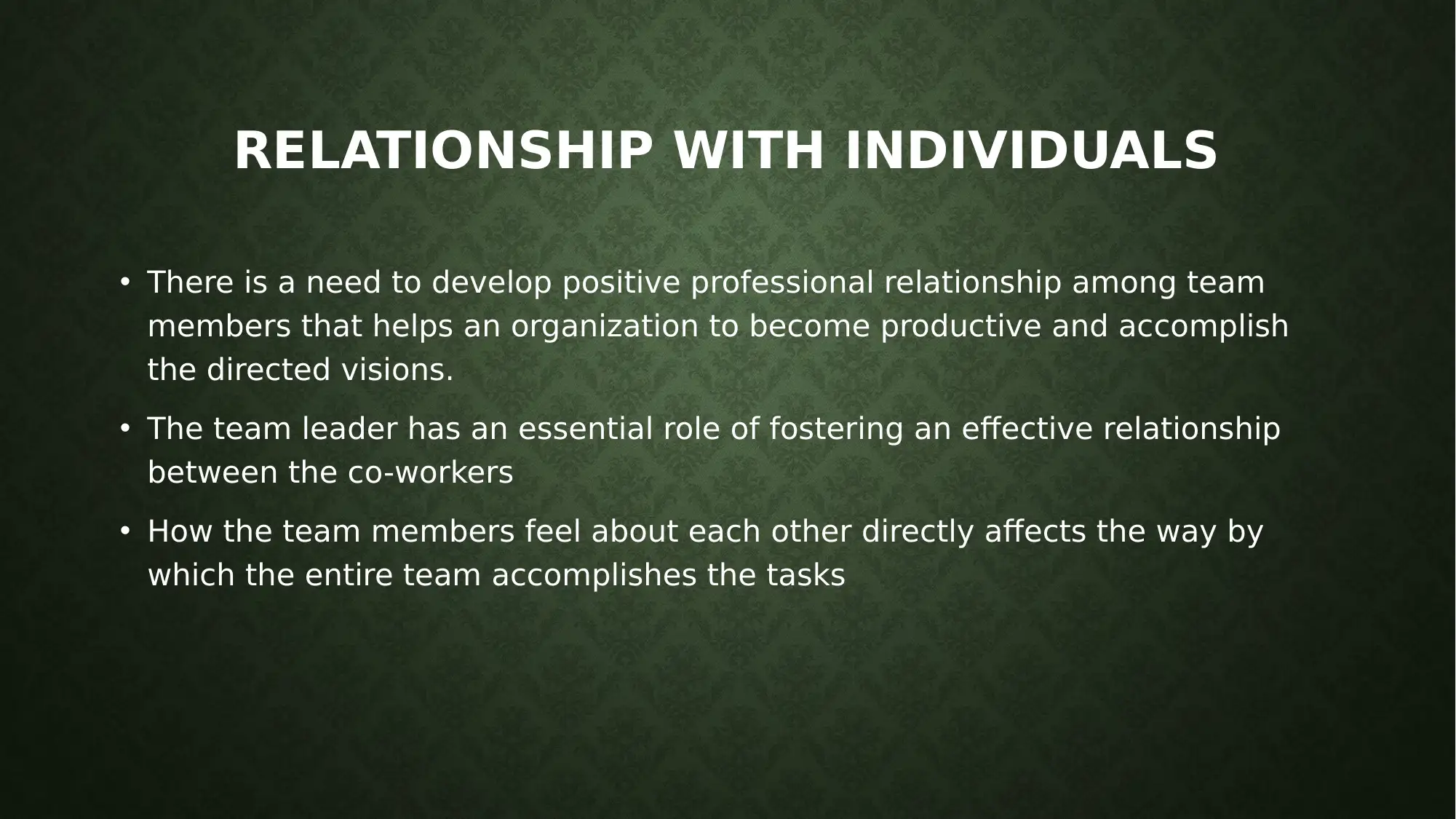
RELATIONSHIP WITH INDIVIDUALS
• There is a need to develop positive professional relationship among team
members that helps an organization to become productive and accomplish
the directed visions.
• The team leader has an essential role of fostering an effective relationship
between the co-workers
• How the team members feel about each other directly affects the way by
which the entire team accomplishes the tasks
• There is a need to develop positive professional relationship among team
members that helps an organization to become productive and accomplish
the directed visions.
• The team leader has an essential role of fostering an effective relationship
between the co-workers
• How the team members feel about each other directly affects the way by
which the entire team accomplishes the tasks
⊘ This is a preview!⊘
Do you want full access?
Subscribe today to unlock all pages.

Trusted by 1+ million students worldwide

POSITIVE RELATIONSHIP
• Communicating with each team
member is imperative for
accomplishing goals in a way that all
members become aware of the
particular talents of the workforce
• Setting goals and building on the
personal strengths is a good approach
in fostering positive relationship.
• Verbal boosts also helps the members
work outside their comfort zone.
• Communicating with each team
member is imperative for
accomplishing goals in a way that all
members become aware of the
particular talents of the workforce
• Setting goals and building on the
personal strengths is a good approach
in fostering positive relationship.
• Verbal boosts also helps the members
work outside their comfort zone.
Paraphrase This Document
Need a fresh take? Get an instant paraphrase of this document with our AI Paraphraser
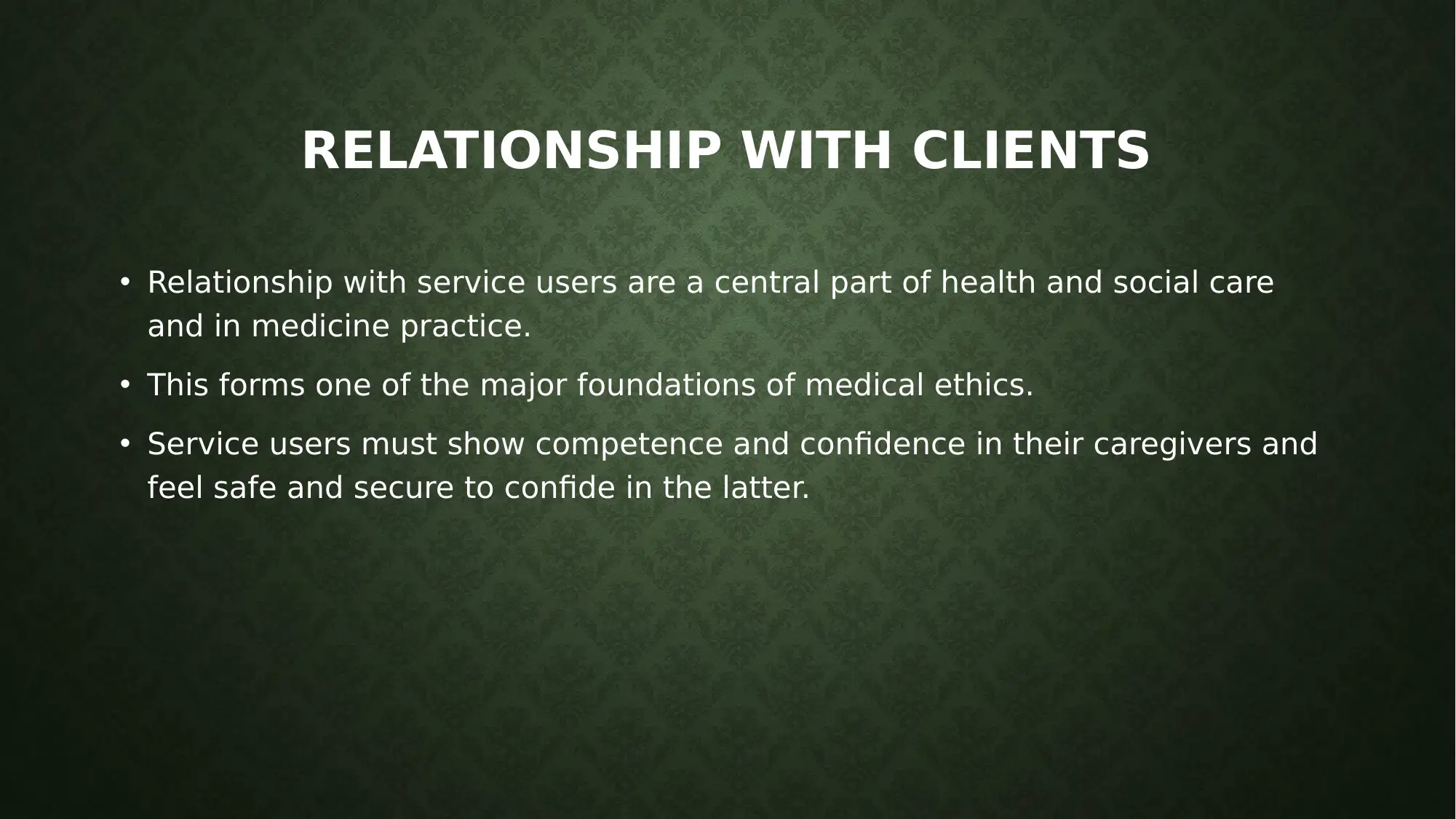
RELATIONSHIP WITH CLIENTS
• Relationship with service users are a central part of health and social care
and in medicine practice.
• This forms one of the major foundations of medical ethics.
• Service users must show competence and confidence in their caregivers and
feel safe and secure to confide in the latter.
• Relationship with service users are a central part of health and social care
and in medicine practice.
• This forms one of the major foundations of medical ethics.
• Service users must show competence and confidence in their caregivers and
feel safe and secure to confide in the latter.
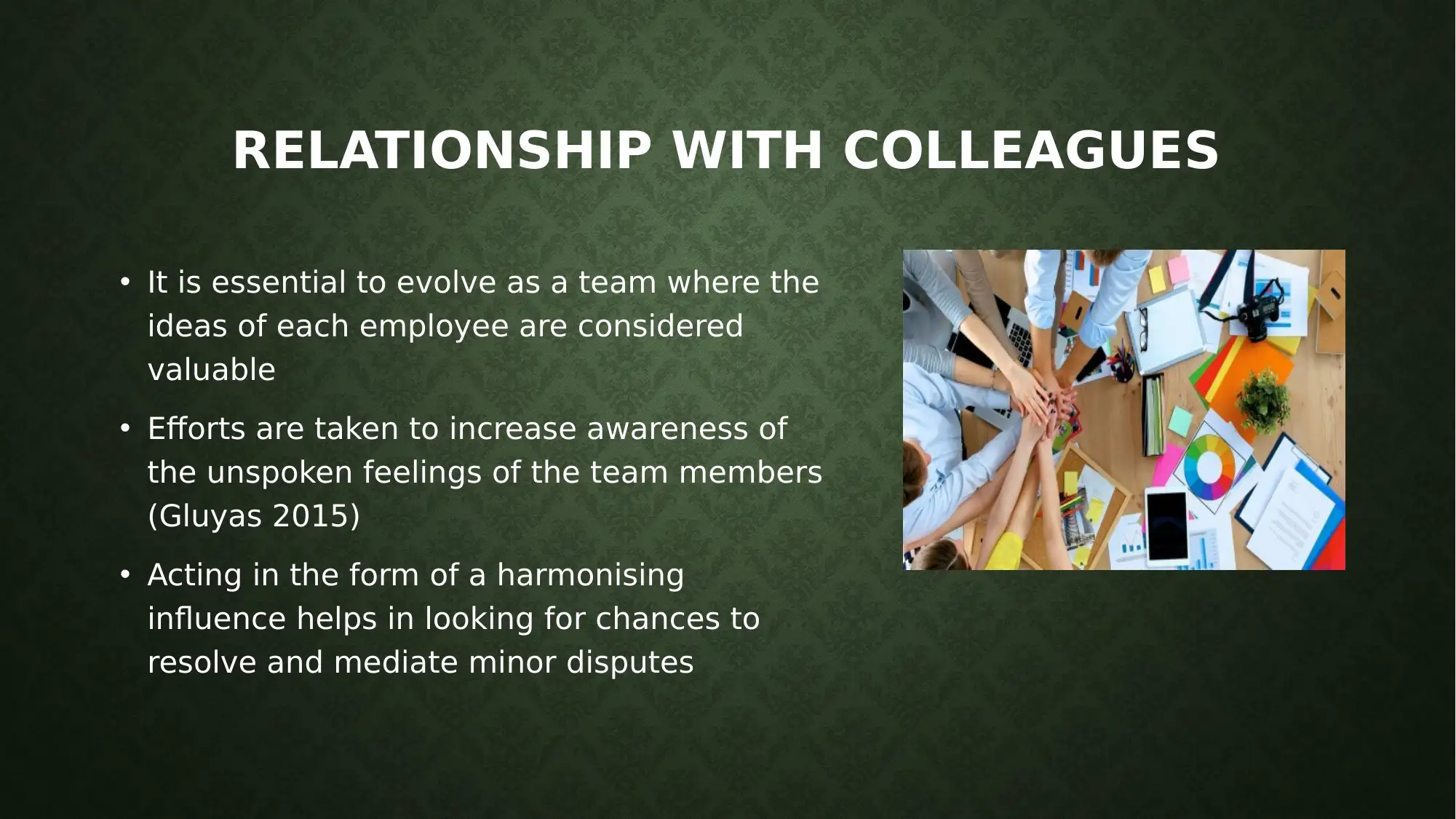
RELATIONSHIP WITH COLLEAGUES
• It is essential to evolve as a team where the
ideas of each employee are considered
valuable
• Efforts are taken to increase awareness of
the unspoken feelings of the team members
(Gluyas 2015)
• Acting in the form of a harmonising
influence helps in looking for chances to
resolve and mediate minor disputes
• It is essential to evolve as a team where the
ideas of each employee are considered
valuable
• Efforts are taken to increase awareness of
the unspoken feelings of the team members
(Gluyas 2015)
• Acting in the form of a harmonising
influence helps in looking for chances to
resolve and mediate minor disputes
⊘ This is a preview!⊘
Do you want full access?
Subscribe today to unlock all pages.

Trusted by 1+ million students worldwide
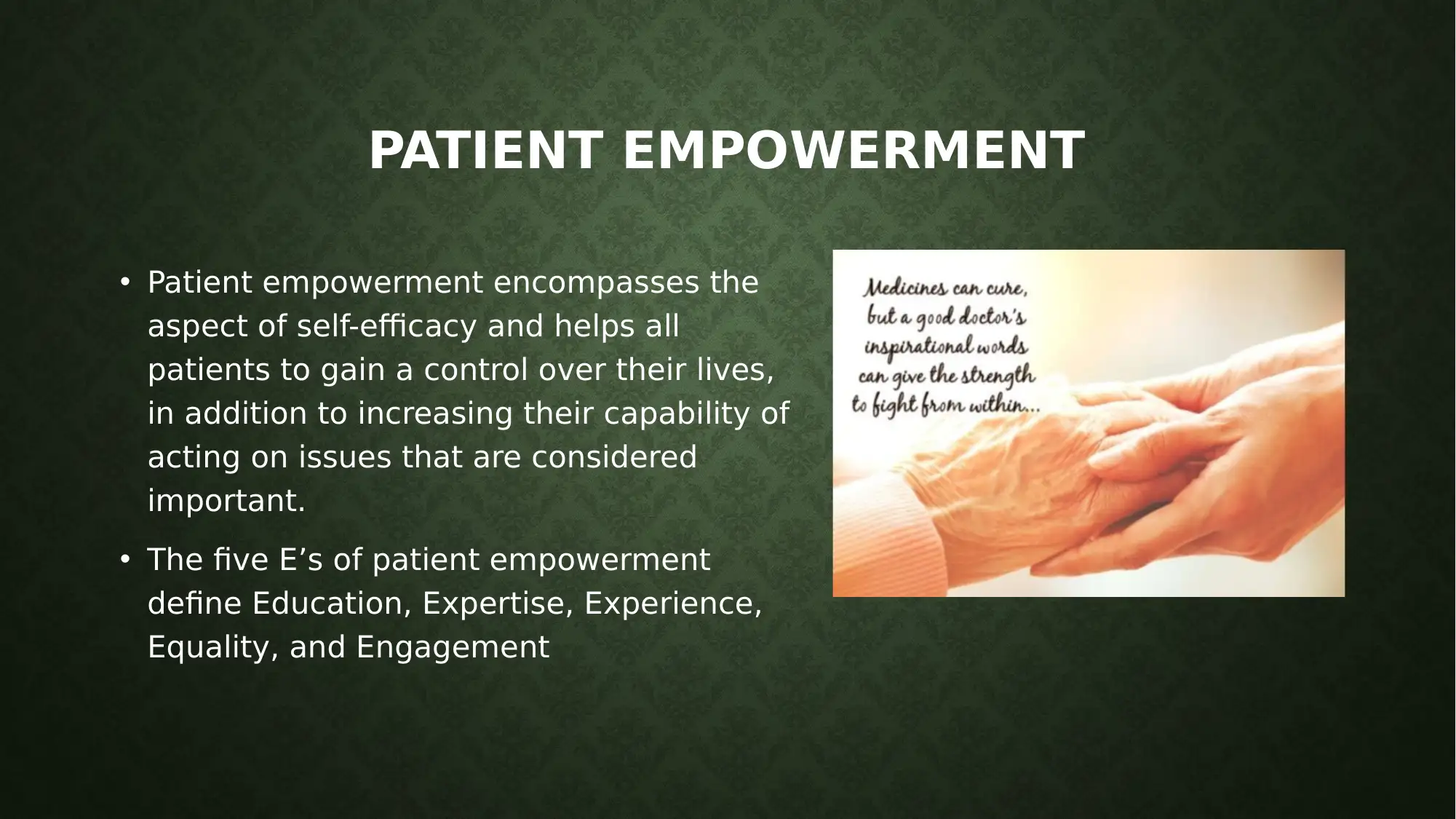
PATIENT EMPOWERMENT
• Patient empowerment encompasses the
aspect of self-efficacy and helps all
patients to gain a control over their lives,
in addition to increasing their capability of
acting on issues that are considered
important.
• The five E’s of patient empowerment
define Education, Expertise, Experience,
Equality, and Engagement
• Patient empowerment encompasses the
aspect of self-efficacy and helps all
patients to gain a control over their lives,
in addition to increasing their capability of
acting on issues that are considered
important.
• The five E’s of patient empowerment
define Education, Expertise, Experience,
Equality, and Engagement
Paraphrase This Document
Need a fresh take? Get an instant paraphrase of this document with our AI Paraphraser
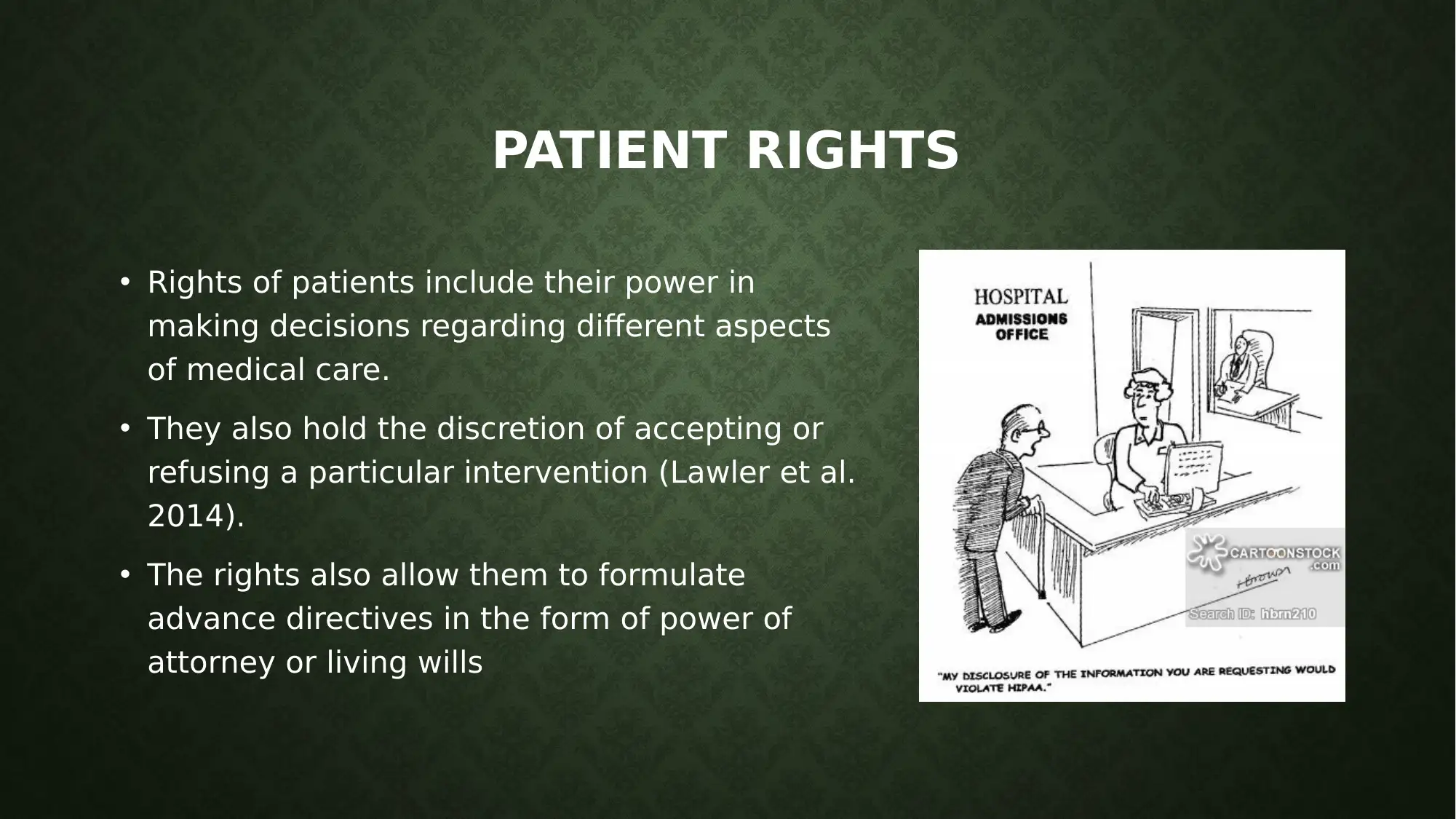
PATIENT RIGHTS
• Rights of patients include their power in
making decisions regarding different aspects
of medical care.
• They also hold the discretion of accepting or
refusing a particular intervention (Lawler et al.
2014).
• The rights also allow them to formulate
advance directives in the form of power of
attorney or living wills
• Rights of patients include their power in
making decisions regarding different aspects
of medical care.
• They also hold the discretion of accepting or
refusing a particular intervention (Lawler et al.
2014).
• The rights also allow them to formulate
advance directives in the form of power of
attorney or living wills
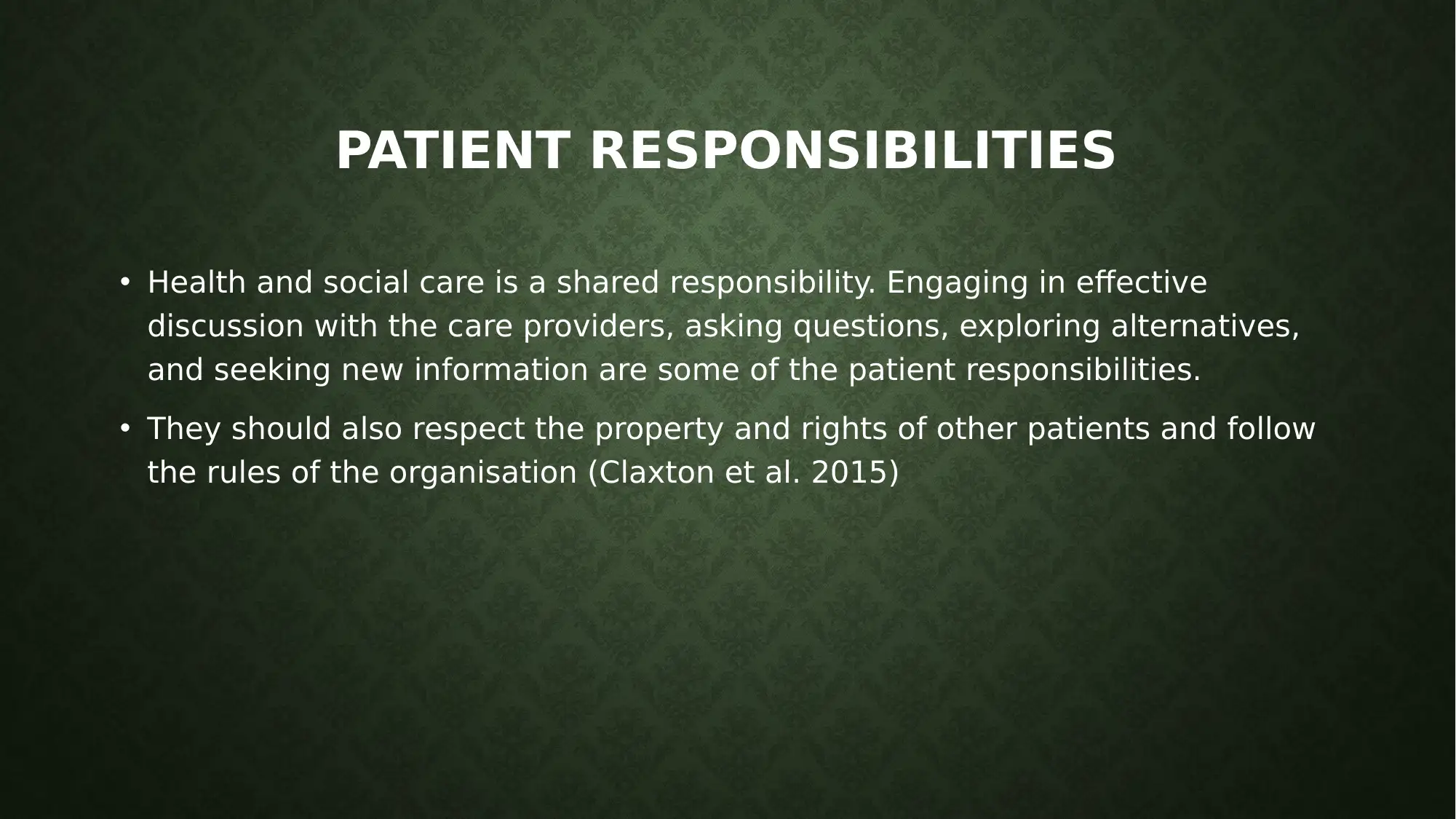
PATIENT RESPONSIBILITIES
• Health and social care is a shared responsibility. Engaging in effective
discussion with the care providers, asking questions, exploring alternatives,
and seeking new information are some of the patient responsibilities.
• They should also respect the property and rights of other patients and follow
the rules of the organisation (Claxton et al. 2015)
• Health and social care is a shared responsibility. Engaging in effective
discussion with the care providers, asking questions, exploring alternatives,
and seeking new information are some of the patient responsibilities.
• They should also respect the property and rights of other patients and follow
the rules of the organisation (Claxton et al. 2015)
⊘ This is a preview!⊘
Do you want full access?
Subscribe today to unlock all pages.

Trusted by 1+ million students worldwide
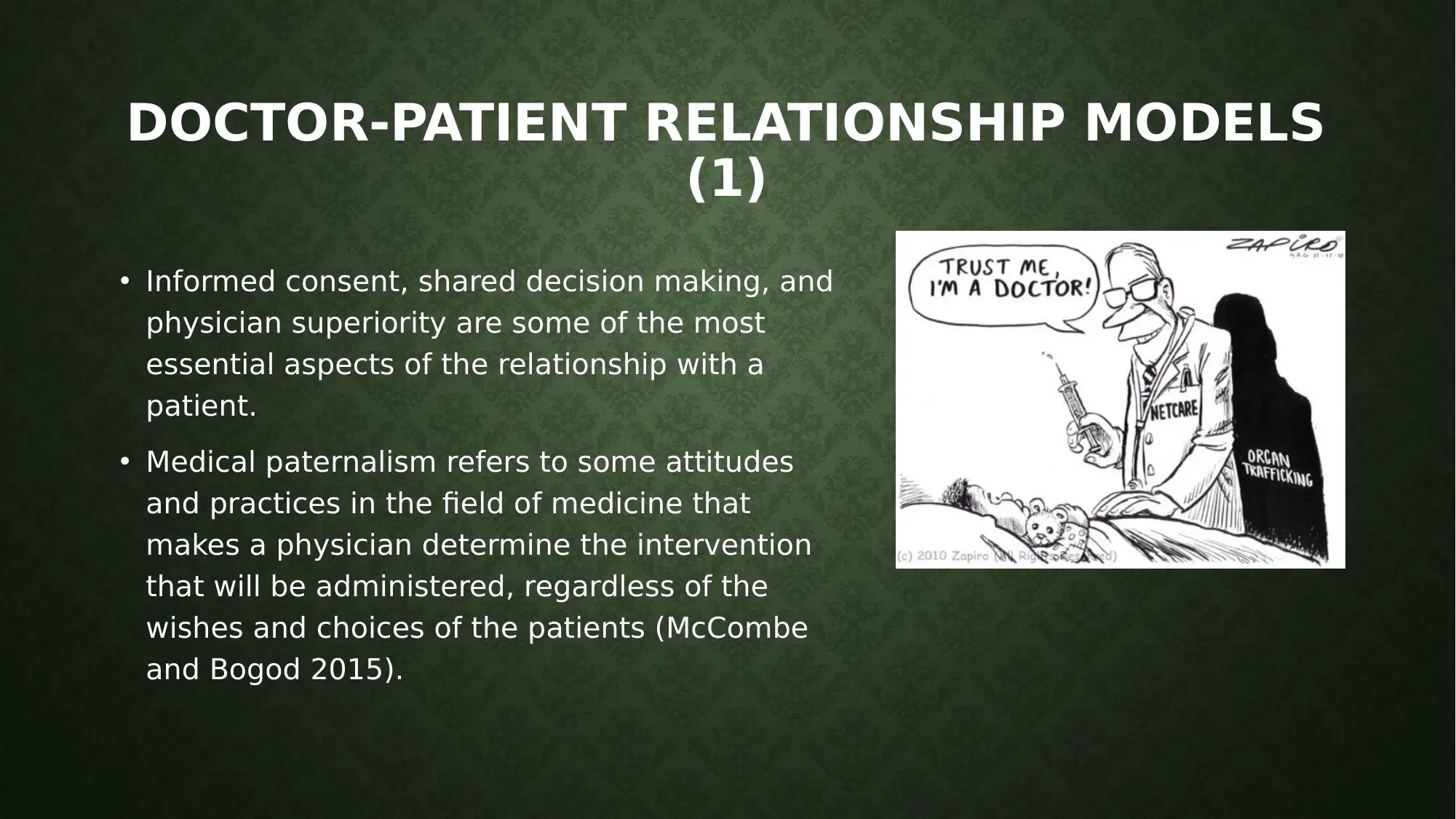
DOCTOR-PATIENT RELATIONSHIP MODELS
(1)
• Informed consent, shared decision making, and
physician superiority are some of the most
essential aspects of the relationship with a
patient.
• Medical paternalism refers to some attitudes
and practices in the field of medicine that
makes a physician determine the intervention
that will be administered, regardless of the
wishes and choices of the patients (McCombe
and Bogod 2015).
(1)
• Informed consent, shared decision making, and
physician superiority are some of the most
essential aspects of the relationship with a
patient.
• Medical paternalism refers to some attitudes
and practices in the field of medicine that
makes a physician determine the intervention
that will be administered, regardless of the
wishes and choices of the patients (McCombe
and Bogod 2015).
Paraphrase This Document
Need a fresh take? Get an instant paraphrase of this document with our AI Paraphraser
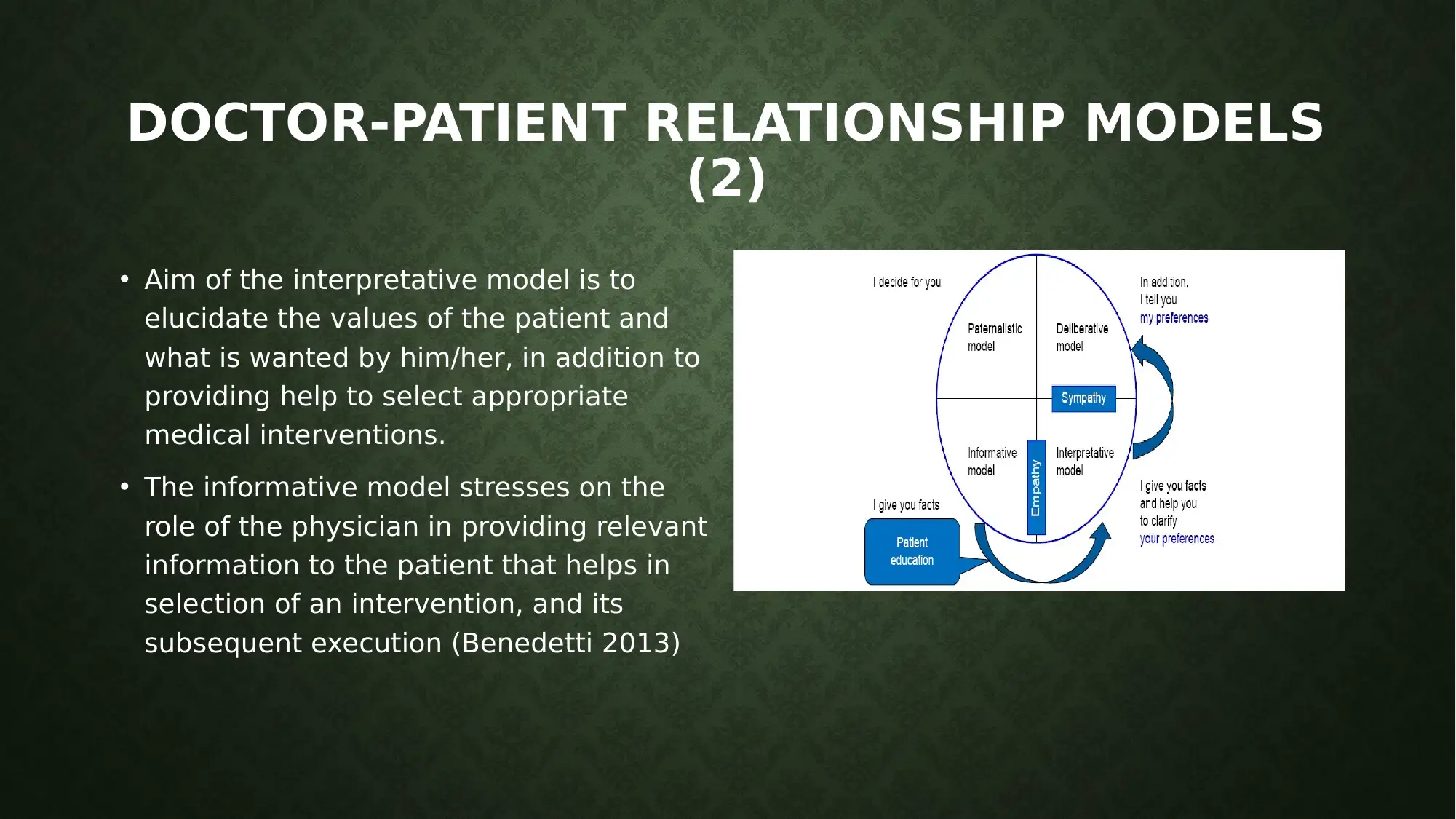
DOCTOR-PATIENT RELATIONSHIP MODELS
(2)
• Aim of the interpretative model is to
elucidate the values of the patient and
what is wanted by him/her, in addition to
providing help to select appropriate
medical interventions.
• The informative model stresses on the
role of the physician in providing relevant
information to the patient that helps in
selection of an intervention, and its
subsequent execution (Benedetti 2013)
(2)
• Aim of the interpretative model is to
elucidate the values of the patient and
what is wanted by him/her, in addition to
providing help to select appropriate
medical interventions.
• The informative model stresses on the
role of the physician in providing relevant
information to the patient that helps in
selection of an intervention, and its
subsequent execution (Benedetti 2013)
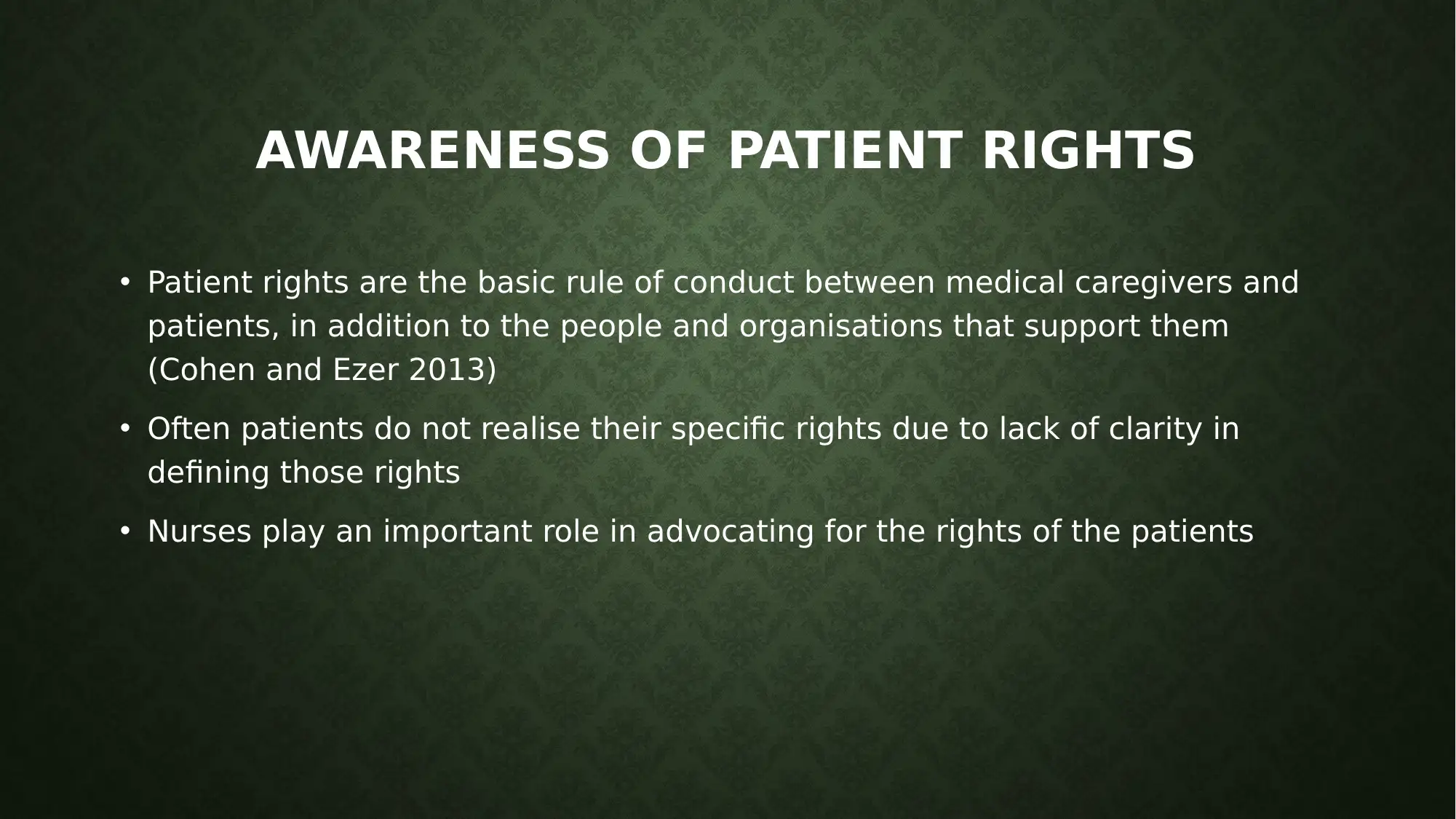
AWARENESS OF PATIENT RIGHTS
• Patient rights are the basic rule of conduct between medical caregivers and
patients, in addition to the people and organisations that support them
(Cohen and Ezer 2013)
• Often patients do not realise their specific rights due to lack of clarity in
defining those rights
• Nurses play an important role in advocating for the rights of the patients
• Patient rights are the basic rule of conduct between medical caregivers and
patients, in addition to the people and organisations that support them
(Cohen and Ezer 2013)
• Often patients do not realise their specific rights due to lack of clarity in
defining those rights
• Nurses play an important role in advocating for the rights of the patients
⊘ This is a preview!⊘
Do you want full access?
Subscribe today to unlock all pages.

Trusted by 1+ million students worldwide
1 out of 19
Related Documents
Your All-in-One AI-Powered Toolkit for Academic Success.
+13062052269
info@desklib.com
Available 24*7 on WhatsApp / Email
![[object Object]](/_next/static/media/star-bottom.7253800d.svg)
Unlock your academic potential
Copyright © 2020–2025 A2Z Services. All Rights Reserved. Developed and managed by ZUCOL.





